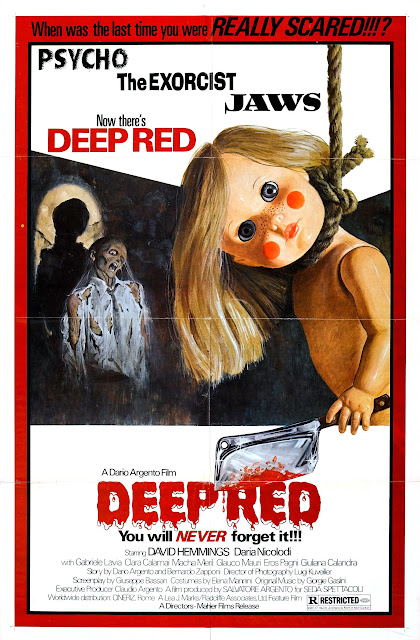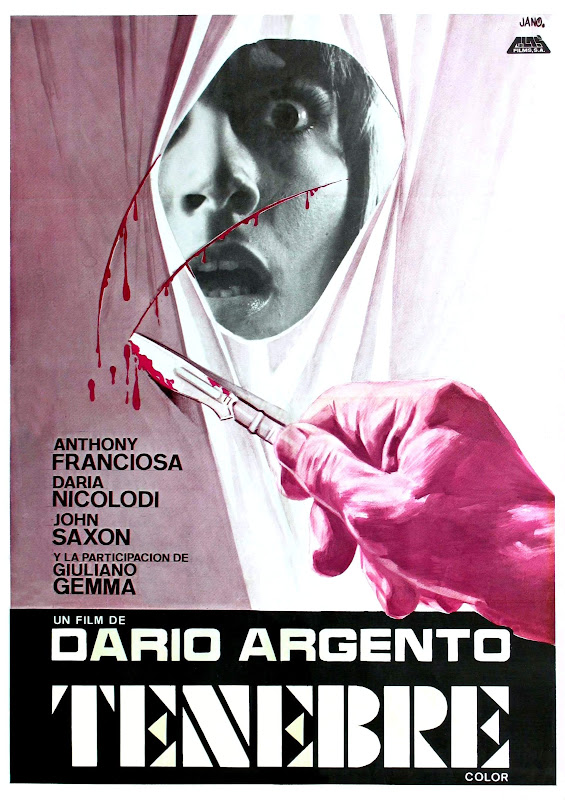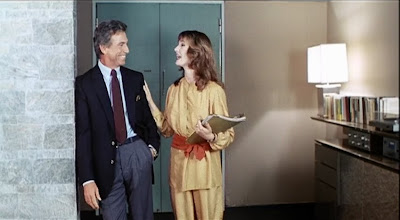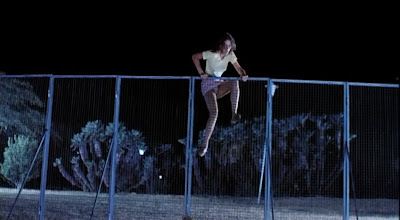Chopping Mall
Chopping Mall was my first blog, which I started way back in 2009. It was dedicated exlcusively to ridiculous and terrible films, which I watched a lot of back then. (So much time, so little work!)
I’ve resuced the posts from oblivion, to be preserved here for …uh… whatever.
It’s a pretty clunky process getting them out of blogspot (XML export, eww) and into here, so there may be a few formatting issues.
Profondo Rosso [aka Deep Red]

Well, after the (comparatively) low point of Four Flies…, the week got right back on track with the superb Argento masterpiece that is Profondo Rosso. This is a film very much in the Bird with the Crystal Plumage vein; it’s giallo murder mystery through and through. On top of that, it’s done extremely well.
Here, more than anywhere, I’ll have to tread very carefully in not giving away spoilers. Deep Red, you see, has a more carefully constructed plot than most Argento films and, as well as not knowing to the very end who’s responsible, we actually care! It’s a film that is more perfectly balanced than his other movies. Phenomena, for all that it was a great watch, has a very long period of almost-nothing-happening through the middle (although the awesomeness of the end makes this easy to forgive!), but Profondo Rosso is a much more polished piece. Information is given away little by little, red herrings and genuine clues are tumbled together into a mix that is never less than enthralling (Enthralling seems a little too fancy a word, but I’m aware that I’ve called nearly every Argento film this week ‘compelling’…). And never fear, the end certainly lives up to the standard set by the rest of the film!
On top of a much more involving plot, the film retains all the other Argento staples, all feeding into the near perfect mix. The Goblin theme tune is piercing synth-perfection, creeping gently into a previously silent scene as the camera bobs and weaves. Like all the best Argento moments, the atmosphere here is tense and threatening. You only need to hear the bass-line fading in as the camera slides slowly across the scene and your heartbeat rises.
This is, as I have said repeatedly already this week, an experience more than a narrative (even if the narrative is stronger here!). Argento films play to the senses, appeal to the nerves, excite your pulse and quicken your breath. To an extent, these work best if you can disengage your brain slightly: we tend to watch films with a keen critical eye, removing ourselves emotionally in order to pass sterile judgements on acting quality, narrative etc. Forget that. Don’t analyse an Argento film, watch an Argento film. The hardest part of writing about these films is remembering the finer details of the films; I know I had a thoroughly enjoyable two hours, that I was shocked at times, tense at times, laughing at times (Gianna’s knackered car provides welcome comic release).
Profondo Rosso is an excellent film, a fantastic journey and a great starting place for anyone who hasn’t seen an Argento film. It’s perhaps not my favourite - I lean toward the psychological horror rather than the murder mystery - but it’s a great film to watch.
Excellent theme tune:
Four Flies on Grey Velvet

[AKA 4 mosche di velluto grigio]
This is certainly going to be the slimmest write-up of any of this week’s Argento films. I’d seen Four Flies… before but I could remember almost nothing about it, something which is very rarely a good sign!
To be fair to Argento, before I’m critical, this was only his third film as director. Following in much the same vein as Bird with the Crystal Plumage, this is a film that is far more closely linked with more traditional crime and mystery films than with the tense horror he went on to make. Four Flies… shows many early versions of what would become Argento tropes; it treads a line somewhere between murder mystery and actual horror but is always slightly unsure of where it really lies.
Several of the elements that came to be used so potently in future films - suggestions of the occult, witchcraft and magic - are present but in much more basic forms, forms which occasionally work but often don’t. By way of example, (and although I would never invest too much hope in an Argento plot), the use in Four Flies of a radical new science technique that captures exactly what the eye saw before death is not supernatural, it’s just silly. This is the kind of thing that undermines a film, especially a film of the kind Argento produces; suspension of disbelief can be carried a long way (especially when we’re enjoying ourselves!) but when something strikes the viewer as being silly, all tension is lost.
This is, much like the other criticism/faint praise this week, not to suggest that Four Flies is a bad film. It’s not. It’s enjoyable, it has a couple of good murders in it. It leaves you guessing for much of its duration. It is not, however, a great film. It is, to my mind, a far cry from the ‘classic’ Argento and, although we might excuse it for being a formative exercise in style, it doesn’t stand on its own legs as a powerful or memorable film. One to watch in a spare moment but, if you’ve never seen an Argento film, not a great place to start.
Phenomena

Another new (to me) Argento film, another next-day post. The problem this time, though, is that I still don’t know what to think. Phenomena has me confused; it could either be my least favourite Argento film yet or it could even be - whisper it- my favourite. I certainly will need to see it again beofre I’m sure.
It has all the faults you could accuse an Argento film of, and it has them by the bucketfull. The story is pretty much nonsensical. The dialogue is clumsy. The acting is as wooden as it gets. If I wanted (and several IMDB reviewers have wanted to) I could make this sound like a truly awful film. It’s about a half-mad girl who communicates with insects, for heaven’s sake!
So… it’s a bad film right?
Wrong.
Phenomena is, as with so many of these films, not really meant to be a narrative to follow, a dramatic performance to astound or a literary tour-de-force. It’s an experience. It’s a film you have to sit and give your full attention to. So surrender your art-critic pretensions and just immerse yourself in it. There’s a lot to like!
She does, after all, communciate with insects! This, predictably, does not mean talking to ladybirds but rather invokes biblical-plagues of flying terrors, ready to sting, nibble and smother anything in their way.
It also has Donald Pleasence (always a good thing) and a monkey.
And…
Welll…..
If I seem to be struggling to find useful things to say about this film it’s really only because it has such an absolutely brilliant, arresting, throat-grabbing, mind-boggling wonder of an ending. The film was good, sure, but the last quarter of an hour or so utterly trumped it. It’s not frightening as such (there’s certainly no scene to equal the dog-chases-girl in Tenebrae) but it is tense, it is shocking and it is delivered with enthusiasm and panache!
It would be such a shame to spoil it for anyone who hasn’t seen it, so I’ll carefully guard my tonguer (er… keys?) and leave you with a very unsatisfactorary conclusion. Phenomena is quite possibly utter rubbish with a chilling ending. Or it is quite possibly a stunning film that needs to be experienced. I’m just not sure.
Either way, I certainly need and want to watch it again.
Tenebrae (pt II)

It it, I’d say, quite fitting that Tenebrae, as the first Argento film of the week that I hadn’t previously seen, is the first that I write about with a little more space to reflect on it. And yet… still, I just don’t quite know what to make of it. Was it absolutely stunning? Was it run-of-the-mill? Was it powerful and tense? Or was it just a bit silly?
As I was watching the film - up to about 2/3 of the way through, at least - I was none too taken in by it. It seemed pretty much your typical slasher. As per usual, it was shot beautifully, as per usual the deaths were gleefully brutal but… there really didn’t seem an awful lot that marked it out from the crowded field. It has people being killed. It has ransom-note style anonymous letters. The lead character just happened to be in Italy at the time (this seems to be quite an Argento trope…). Mysterious phone-calls! Someone wearing a mask! The basic plot elements are all just a little too… average.

But this is Argento! So perhaps it was unreasonable of me to be concentrating too hard on the plot, after all. Again, however, I found myself feeling disappointed. Although there were a handful of interesting camera angles I felt like something was missing; why wasn’t the camera taking such an excitingly active role as in some of the others? In this, I must now admit, I was just plain wrong. The camera work in Tenebrae is fabulous. It does half of the same things as in his other films but - crucially - you hardly notice it at all. This is surely the best cinematography of all, camera work that grabs you, changes the way you relate to the story and yet remains unobtrusive.

I’m still not sure, though. My appreciation of the film languished at a low-point throughout much of the film, rose unexpectedly to a fever-pitch of wow-that-was-awesome at the end but, with a day’s reflection, has returned to something middling really. It’s not that it’s not an awful lot of fun, it’s simply that it doesn’t cry out in quite the same way as something to be remembered. It doesn’t feel as gloriously unique as some of the others.
I should add, however, that whilst that assessment might be true of the film as a whole, there certainly were a few memorable moments. The extended scene in which a girl is chased by a dog (I really don’t want to give too much away) was Argento at his sublime best. No dialogue, just a building tension (carried wonderfully by Goblin’s score) that makes the scene almost painful to watch but impossible to turn away from. When Tenebrae gets it right, it gets it very right!


Tenebrae (AKA Tenebre)
Tonight’s film was Tenebrae, the first one that was new to me. Sadly, I’m way too tired to write about it now, so it can wait until the morning.
For now, fans of Justice’s ‘Phantom Parts I & II’ should probably check out the Tenebrae theme tune, contributed by repeated-Argento-collaborators, Goblin.
Justice:
Goblin: